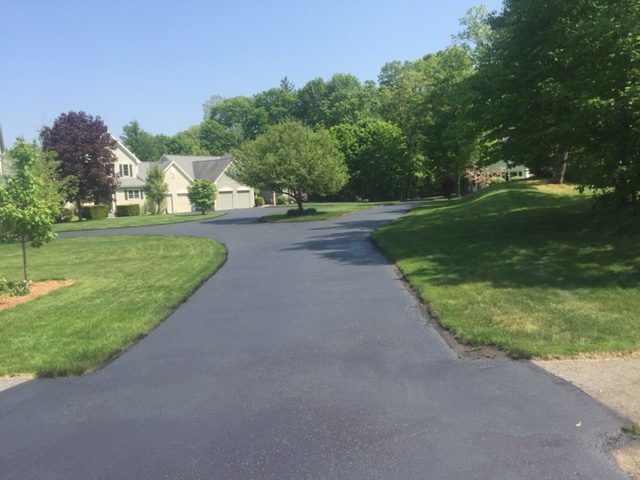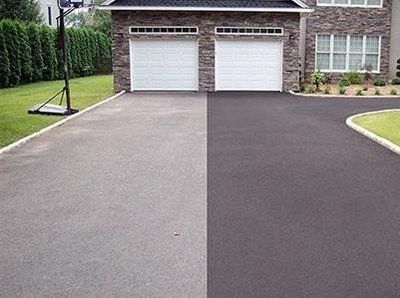Revitalize Your Residential Property with Regrading and Asphalt Sealing Techniques
Revitalize Your Residential Property with Regrading and Asphalt Sealing Techniques
Blog Article
Warm Mix Asphalt: A Lasting Solution for Sidewalk
Warm Mix Asphalt (HMA) has actually arised as a leading sustainable selection for sidewalk services, providing a myriad of environmental benefits and cutting-edge technologies. Its capability to recycle products and lower power usage offers an engaging case for its adoption in road building jobs. In addition, the long-lasting efficiency and toughness of HMA make it a preferred alternative for facilities growth. As the need for eco-friendly building and construction methods grows, exploring the nuances of HMA's sustainability can give valuable insights into the future of sidewalk remedies.
Environmental Advantages of Warm Mix Asphalt

Additionally, Warm Mix Asphalt assists to reduce metropolitan heat island impacts. Its dark color absorbs sunlight, reducing the quantity of warm showed back right into the ambience contrasted to lighter-colored pavements. This can lower ambient temperature levels in city locations, decreasing the demand for cooling and inevitably minimizing energy intake.
In enhancement, Hot Mix Asphalt adds to enhanced stormwater monitoring. Its porous nature allows water to reenergize and infiltrate the sidewalk groundwater materials, decreasing drainage and the danger of flooding. These environmental benefits make Hot Mix Asphalt a sustainable choice for paving freeways and roadways.
Power Effectiveness in HMA Manufacturing
Is energy efficiency an essential factor in the production of Warm Mix Asphalt (HMA)? Power plays a substantial role in the production of HMA, affecting both expense and ecological sustainability. One vital aspect of energy effectiveness in HMA manufacturing is the use of cozy mix asphalt (WMA) innovations.
Moreover, improvements in plant innovations have led to more energy-efficient HMA manufacturing processes. By maximizing energy usage in HMA manufacturing, the industry can minimize its carbon impact while keeping top quality pavement materials.
Recyclability of Hot Mix Asphalt
The recyclability of Hot Mix Asphalt (HMA) is an essential aspect of its sustainability and long-term ecological effect. HMA is among the most recycled products in the United States, with over 100 million lots of recovered asphalt pavement (RAP) being recycled annually in new pavement construction. Reusing HMA offers a number of ecological benefits, such as minimizing the demand for virgin materials, lowering energy usage throughout manufacturing, and decreasing the amount of waste sent to garbage dumps.
The process of recycling HMA entails crushing the existing sidewalk, crushing it into smaller items, and blending it with new aggregate and asphalt binder to develop a recycled mix. On the whole, the recyclability of HMA plays a substantial role in promoting lasting practices within the pavement market.

Long-Term Efficiency of HMA
Asphalt pavements show toughness and durability over an extended period, showing the long-term performance of Warm Mix Asphalt (HMA) The durability of content HMA can be connected to its capability to stand up to hefty traffic tons, rough weather, and the impacts of aging. Researches have actually shown that well-designed and appropriately created HMA sidewalks can last for 20 years or more with regular maintenance. The secret to maximizing the long-lasting performance of HMA lies in utilizing high-grade products, following best practices in building, and executing efficient upkeep techniques. Correct drain, routine inspections, and prompt repair work are important for preserving the architectural honesty of HMA sidewalks with time. Furthermore, innovations in HMA innovation, such as making use of polymer-modified binders and cozy mix asphalt, have further boosted the sturdiness and longevity of HMA sidewalks. By prioritizing top quality building and upkeep methods, HMA proceeds to show itself as a sustainable and economical option for durable pavement infrastructure.

HMA: Sturdiness and Sustainability
Showing both resilience and sustainability, Hot Mix Asphalt (HMA) has become a cornerstone in the construction of resilient sidewalk infrastructures - angled parking. HMA's toughness stems from its capability to stand up to hefty tons, extreme weather, and high web traffic volumes, making it a trustworthy selection for roadways, highways, and flight terminal runways. The structure of HMA, which normally includes aggregates, binder, and filler, plays a crucial role in boosting its long life and resistance to tear and put on
Furthermore, HMA's sustainability exists in its recyclability and energy-efficient manufacturing process. The capability to recycle redeemed asphalt pavement (RAP) in new HMA mixtures reduces the need for virgin products and minimizes the environmental impact of sidewalk construction and maintenance. Furthermore, the power effectiveness of producing HMA depends on its reduced mixing temperatures compared to other sidewalk products, bring about minimized energy intake and greenhouse gas discharges.
Conclusion
Finally, warm mix asphalt (HMA) supplies a lasting remedy for sidewalk with its ecologically friendly features. HMA's recyclability, Go Here power effectiveness in production, and lasting toughness make it an environment-friendly option for road building and construction. By saving natural sources, lowering waste, and decreasing greenhouse gas discharges, HMA plays an essential duty view it now in advertising sustainability in framework advancement. Its capacity to mitigate urban warmth island results better highlights its value in creating ecologically conscious and resilient sidewalk systems.
HMA is one of the most recycled products in the United States, with over 100 million bunches of reclaimed asphalt pavement (RAP) being reused annually in new pavement building.The procedure of reusing HMA involves grating the existing pavement, crushing it into smaller pieces, and mixing it with brand-new aggregate and asphalt binder to develop a recycled mix.Asphalt pavements show toughness and resilience over an extensive period, mirroring the lasting efficiency of Warm Mix Asphalt (HMA) In addition, advancements in HMA technology, such as the usage of polymer-modified binders and cozy mix asphalt, have better improved the longevity and durability of HMA sidewalks. The ability to reuse redeemed asphalt sidewalk (RAP) in brand-new HMA blends lowers the need for virgin products and decreases the environmental impact of pavement building and construction and upkeep.
Report this page